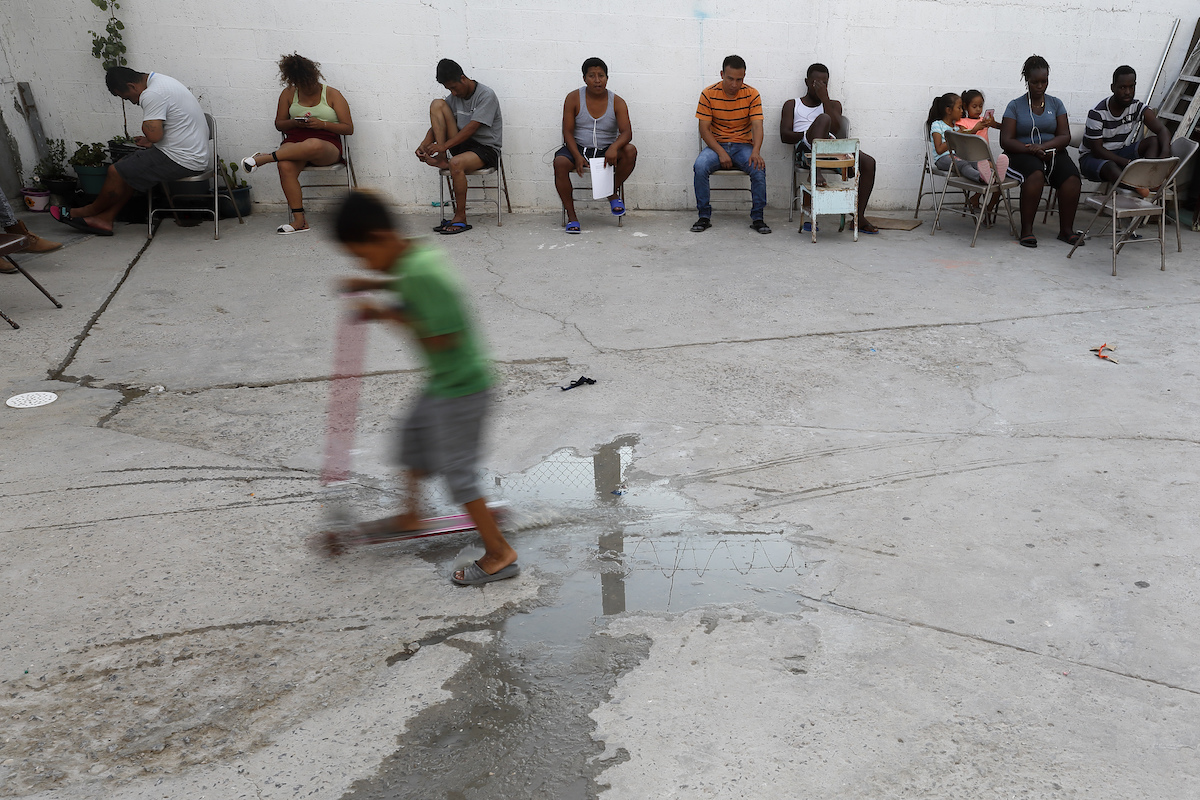

In this July 26, 2019, photo, people from Africa and Central America sit in chairs as the sun sets at El Buen Pastor shelter for migrants in Ciudad Juárez, Mexico. (AP Photo/Gregory Bull)
By CEDAR ATTANASIO and TIM SULLIVAN, Associated Press
This story is part of an occasional series, “Outsourcing Migrants,” produced with the support of the Pulitzer Center on Crisis Reporting.
JUÁREZ, Mexico (AP) — Long after midnight, when the heat has finally relented and the walled courtyard is scattered with men sleeping in the open, someone begins to sob.
The sound is quiet, muffled. The only light comes from streetlights shimmering above the razor wire. It’s impossible to see who is crying.
Is it the Ugandan bodybuilder who came here fleeing political violence? Or the 27-year-old El Salvadoran who often wears a Cookie Monster t-shirt? Maybe it’s the young Honduran husband who rarely leaves his wife’s side.
It could have been any of them.
This is the cobbled-together community of El Buen Pastor —The Good Pastor— 130 or so migrants from around the world locked into a shelter every evening at 5:30 p.m., trapped in an immigration purgatory. They are barely three miles from the Paso del Norte Bridge and their goal: the United States.
“Everyone cries here,” says Yanisley Estrada Guerrero, a 33-year-old Cuban economist and former bank manager. She’s now working illegally as a housekeeper at a Juárez hotel for $60 a month, less than half Mexico’s minimum wage. “I still cry almost every day. But I do it in the shower, because I don’t want anyone to see.”
These are turbulent days for the migrants of El Buen Pastor. For the first time since World War II, the U.S. government is turning away thousands of asylum seekers regardless of their need for refuge.
A series of Trump Administration immigration rule changes have effectively sealed the border to the vast majority of asylum seekers, leaving tens of thousands of migrants in limbo, and shifting responsibility for U.S. immigration policy to the Mexican government and dozens of Mexican shelters.
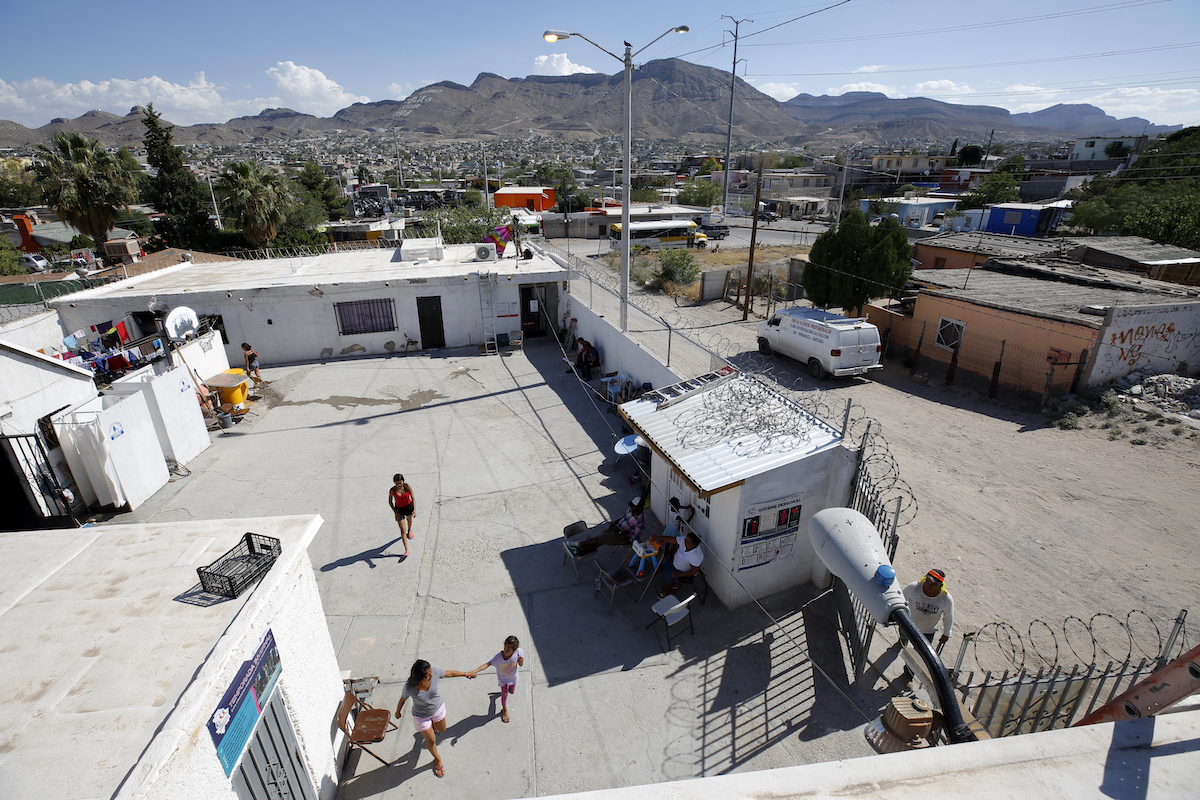

In this July 30, 2019, photo, people walk through the patio at El Buen Pastor shelter for migrants in Ciudad Juárez, Mexico. (AP Photo/Gregory Bull)
For migrants, El Buen Pastor is both a haven and a prison. It’s a small place —four sleeping rooms, four showers, four toilets and a chapel— that provides each arrival with a mattress, two meals a day, spotty wi-fi and protection from gangsters who trawl for targets in migrant enclaves of Juárez. But it’s also a place where the front gate is locked at 5:30 p.m., and coming in late means facing Marta, the fearsome Bible-quoting unpaid staffer who never seems to leave.
The shelter ripples with often-unspoken bigotries, with ribbons of race and class and education in nearly every interaction. Daily life is marked by brutal summer heat, occasional dust storms, crushing boredom and the guilt of mothers who can’t afford dinner for their children.
But occasionally, it’s also a place of muchene enkoko (Ugandan-style chicken and rice) and arroz a la valenciana (Nicaraguan-style chicken and rice). It’s a place of children’s games, young romance and Scrabble matches that seem to stretch into eternity. Anything to make the time pass.
It’s home, at least for now, for those 130 or so people.
This is how they spend their days. Not in the countries they fled. Not in the country where they want to be. But somewhere else, in between.
***
The Ugandan bodybuilder wakes early, often before everyone else, and heads out into the streets of Juárez to run.
Alphat runs relentlessly. People stop to stare, surprised to see a black man with ham-sized biceps and impossibly broad shoulders running through this city.
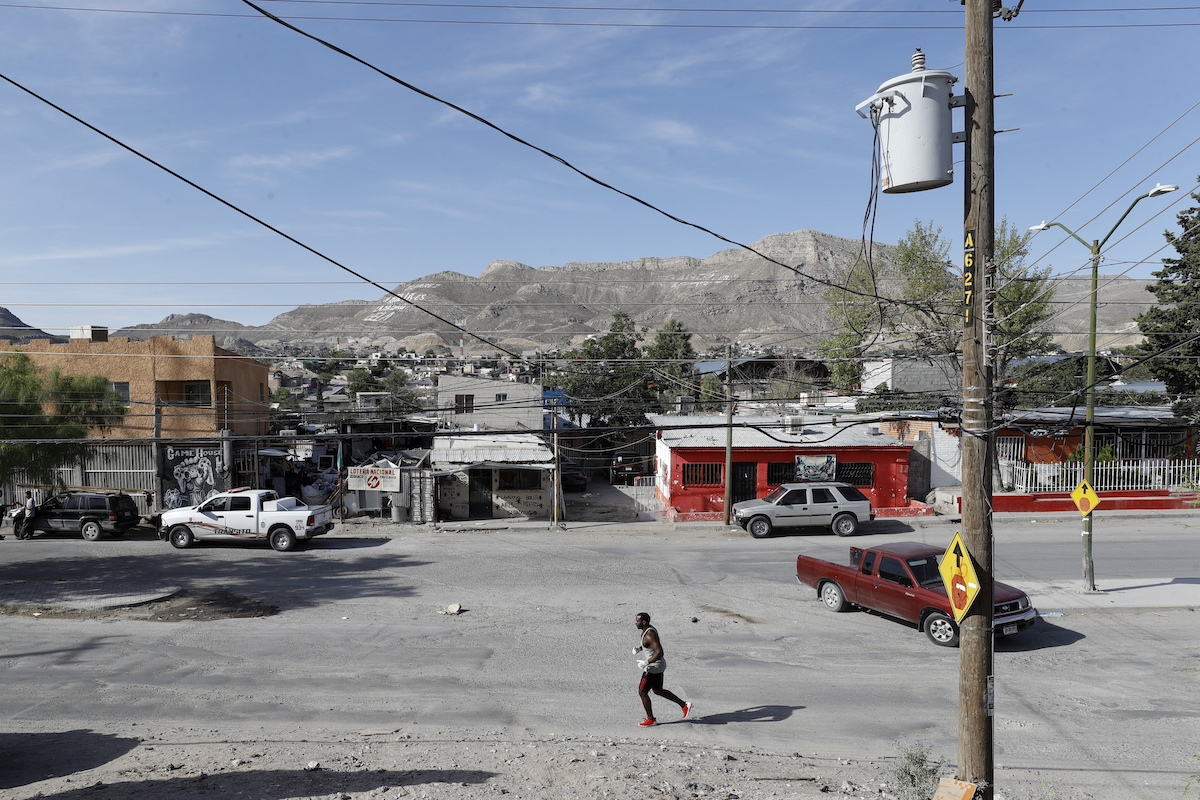

In this July 31, 2019, photo, Alphat, of Uganda, runs through a neighborhood surrounding the El Buen Pastor shelter for migrants in Ciudad Juárez, Mexico. (AP Photo/Gregory Bull)
Until recently, most migrants to Juárez came from poor, rural Mexican states, often looking for jobs in the city’s hundreds of factories. These days they come from around the world, hoping to reach the U.S.
El Buen Pastor is home to migrants from 11 countries, from Cameroon to Cuba, Ethiopia to Guatemala. Mexican officials estimate there are roughly 13,000 of these migrants in Juárez, a city of 1.3 million people. Across Mexico, there are an estimated 50,000. They arrived after hiking through the jungles of Panama or flying directly to Mexico City. They took buses through Guatemala. They walked. Most migrants at El Buen Pastor fled political violence, authoritarian rulers or the relentless extortion of gang-controlled neighborhoods. Some have college degrees. Some are barely literate. Many dream of leaving behind generations of poverty. Most have no idea when they’ll go anywhere.
Alphat runs to escape the stifling closeness of the shelter, and to forget for a few minutes what happened back home.
A 29-year-old competitive bodybuilder, Alphat also owned a gym and a security company that provided bodyguards. His nightmare began, he says, when he agreed to handle security for a politician who has clashed repeatedly with Yoweri Museveni, the strongman who has run Uganda for more than 30 years.
Eventually, he says, he was arrested, beaten and tortured because of his opposition ties. Policemen used string to hang heavy blocks from his penis. While he was in detention, his wife and two young daughters were shot and killed by military policemen, who had warned him to drop his political client.
He has struggled with depression but he doesn’t weep when he talks about their killings, doesn’t ask for sympathy.
“They wanted to punish me,” he says simply.
He sold his gym and his car and fled to Kenya. When that didn’t feel far enough he found a murky middleman named Moses. Alphat paid him $7,000 to arrange a series of flights: Kenya to Ethiopia to Argentina to Mexico City.
At first, he thought he’d find refuge in Mexico. But after being detained, released and then robbed, he took the advice of a Mexican he’d met and rode a bus to Juárez. Here, he’d been told, he could walk to a U.S. border post and ask for asylum.
The bridge linking Juárez and El Paso is one of America’s busiest border crossings, channeling roughly 20,000 pedestrians a day back and forth.
Alphat’s taxi driver, taking pity on him, gave him a five-peso coin, worth 25 cents, to cross the bridge.
“OK, now I’m settled,” he thought as he dropped the coin into the turnstile and began walking above the dry riverbed of the Rio Grande. “Now I’ll get my freedom.”
But halfway across he was stopped by U.S. customs officers.
Little did he know that the Trump administration was turning away more and more asylum seekers with a vague promise to process them later. So many migrants lined up on the bridge waiting to cross that local Mexican authorities started assigning numbers, like a ticket for service at a deli, updating the number every day on Facebook.
Alphat’s number: 12,631.
In February, the delay was a few days. When Alphat arrived on April 23, it was two months. In July, processing had virtually stopped, and he had no idea if his asylum interview would ever happen.
But Alphat doesn’t complain. Most people don’t. It’s pointless, and people here are careful not to use up too much energy.
Alphat shrugs: “I’ve been here almost four months, waiting for them to call.”
***
Mornings are the worst, when another heat-blasted day stretches out before them and the courtyard is scattered with half-asleep people blinking at the sun.
Mattresses are taken in, folding metal chairs are dragged out, clanging across the concrete. Parents snap at their children. A handful of people have jobs, many working illegally as housekeepers or construction workers, though Mexican officials have been more generous recently with work permits — recognition that the migrants are here for a while. The workers trudge from the shelter to their bus stops through the neighborhood of rocky hills, potholed roads and small concrete homes with barred windows.
On bad days, Marta calls out the women for a lecture.
Marta Esquivel Sánchez is the moody 59-year-old assistant who cooks most of the meals at the shelter and runs it overnight.
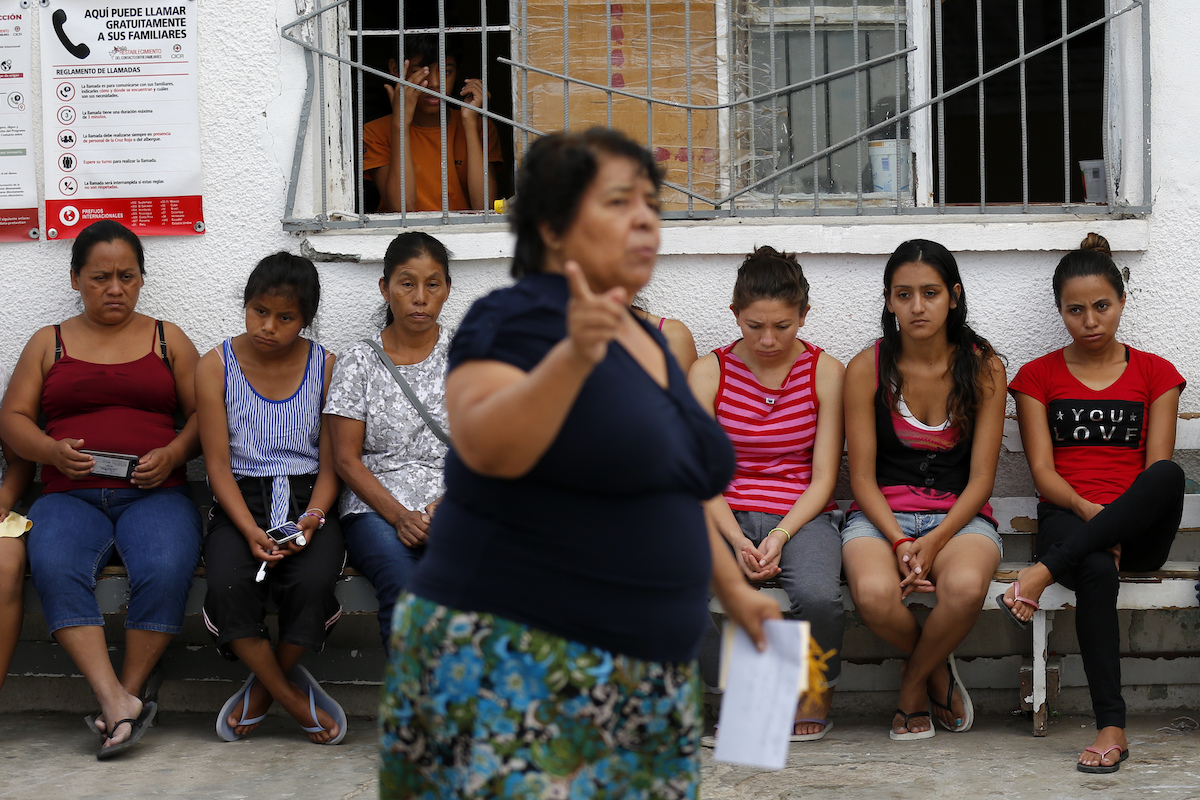

In this July 29, 2019, photo, Marta Esquivel Sánchez, a volunteer at El Buen Pastor shelter for migrants, center, scolds a group of migrant mothers about the care of their children and asks for more help with cleaning at the shelter in Ciudad Juárez, Mexico. (AP Photo/Gregory Bull)
She is both loved and feared. Her lectures are layer cakes of chastisement, the Gospels and guilt.
“I’m human. I get tired,” she tells a half-dozen or so women seated on benches in the courtyard on a July morning. “But I’m here with you doing this for the love of God.”
She ticks through problems: messiness; noisy children; people who come in past the 5:30 curfew, “Wise up or watch what happens!” she declares.
The women say nothing.
***
The man who makes all this work is a retired high school math teacher with jet black hair and the thin mustache of a bygone movie star. Juan Fierro is a 70-year-old lapsed Catholic and recovering alcoholic who eventually found direction in the Methodist church. He’s also a preacher who can lay a hand gently on believers and watch them slump to the floor unconscious, overcome by the Holy Spirit.
But at the shelter, Fierro is simply “El Pastor.”
“The pastor, he sees everything,” says Esquivel, pointing to the shelter’s security cameras.
El Pastor is the lawgiver (no drinking, no smoking, no fighting) and the genial benefactor who supplies everything from food to bus fare to toilet paper.
His desk faces the shelter’s entryway and on most mornings he sits behind it, hands resting on his generous belly, smiling quietly and keeping track of everything. The walls are speckled with framed letters of appreciation, diplomas from workshops and photographs of him with visitors. A monitor displays feeds from more than a dozen security cameras.
He’s an unrepentant optimist—the good cop to Esquivel’s bad cop. But he’s also astonished that in a place full of disparate, frustrated people, there’s so little trouble.


In this July 25, 2019, photo, a Cuban man looks at a computer screen as others lay around the patio at El Buen Pastor shelter for migrants in Ciudad Juarez, Mexico. (AP Photo/Gregory Bull)
“I don’t understand why they’re not at odds with each other,” he said. Prejudices lurk just beneath the surface: Cubans are bossy, the migrants tell each other. Africans smell. Guatemalans are ignorant.
In the spring, trouble appeared ready to explode when a Mexican aid organization brought a group of African migrants to the shelter.
“Everyone stood still, watching them,” Fierro said.
“Are they going to stay with us?” the stunned residents asked him.
A few weeks later, a Central American teenager hurled racial slurs at the Africans and Fierro stepped in. He called all the Latinos together and said talk like that had to stop immediately. Then he took a group of Africans out for ice cream and a drive around town.
The Central Americans in particular, many from isolated villages with little exposure to the wider world, are often shocked to be living with black people.
“We have to show them that we are OK,” said Samrah, a Ugandan migrant, rolling her eyes. “But when a new person comes, we have to do it all over again. ”
For the most part the migrants have learned to get along. Why bother fighting in a place where everyone is sleeping on the same cheap sponge mattresses, and lining up every morning for the same off-brand corn flakes smothered in sugar?
Prejudices melt most quickly among the children, who play together in a tangle of languages and ethnicities and races. The 16-year-old Congolese girl watches the Honduran baby. Sometimes, the adults laugh as they try to learn a few words of someone else’s language.
***
The U.S. Department of Homeland Security insists the January policy returning migrants to Mexico is designed to bring order to the asylum process and “decrease the number of those taking advantage of the immigration system.”
Before the new policy, migrants who passed a so-called “credible fear” screening could stay in the U.S. while immigration courts decided their case. Now, it’s often not clear how the process works.
At first, only Central Americans were sent back to Mexico under the new policy. Then, starting in June, Cubans were also sent back. Pregnant women, non-Spanish speakers, and other vulnerable migrants are sometimes —but not always— allowed into the U.S.
A second administration order, on July 16, effectively denied asylum to most migrants arriving at the border from that day forward, insisting they must first seek asylum in another country they had passed through.
That order split the shelter into winners and losers, and punished many of those who had waited for their number to come up.


In this July 27, 2019 image, a migrant wakes up before sunrise at El Buen Pastor shelter for migrants in Ciudad Juárez, Mexico. (AP Photo/Gregory Bull)
Suddenly, people who had asked for asylum before July 16 —even if they had done so after arriving in the U.S. illegally— could proceed with their asylum applications while they waited in Mexico. But nearly everyone who tried to put in an asylum request after that date would first have to apply for asylum in Mexico or another country they had passed through.
A series of court rulings have made the situation more confusing.
Last week, the U.S. Supreme Court let the July 16 order stand while it considers the case. In a celebratory tweet, acting U.S. Citizenship and Immigration Services chief Ken Cuccinelli said his agency would start enforcing the rule “ASAP.”
Said another Ugandan, a former used car dealer: “It’s very complicated and if you put your brain to thinking about it, you’ll just burn out.”
In June, a union representing U.S. asylum officers challenged the January policy of returning migrants to Mexico in a legal brief, saying it’s “fundamentally contrary to the moral fabric of our Nation.”
Fierro, whose family has been on both sides of the border for generations, presumes the waiting list is designed to exhaust the migrants, to push them to the point where they simply give up and go home.
They “have been worn out emotionally, physically,” he says. “Maybe the moment will come when they don’t want to keep fighting. And I think that’s part of what” U.S. officials want.


In this July 27, 2019, photo, an Ethiopian man reads his Bible in a shower stall as dawn breaks and others return their mattresses after sleeping outside at El Buen Pastor shelter for migrants in Ciudad Juárez, Mexico. (AP Photo/Gregory Bull)
***
The twins are hungry.
The 11-year-old boys are thin and gangly and growing fast, but El Buen Pastor can only afford two meals a day for the migrants. Once lunch is over there’s nothing until breakfast the next morning. For those who arrived with a little hoard of money, or who have family that can occasionally wire them a few dollars, that’s not a big problem. They stock up at grocery stores and cook in the kitchen of a nearby corner market where the owner, an ever-smiling man with a huge cowboy hat, has befriended many of them. Or at least they can buy cookies and potato chips to fend off hunger until morning.
But not the twins’ mother. Jennifer Jiménez-Sánchez, 29, is a single mother from El Salvador with an eighth-grade education who depended on relatives and hawked clothes on the street to make a living back home. Her father and brother were both killed by gangs, which wield immense power in much of the country.
In the end, though, it was an encounter on the street earlier this year that drove her to leave.
She says a man approached her one day as she walked the twins home from school.
She knew who he was. Everyone did in her neighborhood. He was from MS-13, one of El Salvador’s most murderous gangs.
“You have to deliver your sons,” he told her, she recalls. “They are now old enough to come with us.”
He continued: “We’re not asking permission. We’re informing you.”
Her husband was gone. Going to the police was pointless. They fear MS-13 as much as she does.
So she made a decision: “Dawn came, and without saying goodbye to anyone, I went out of my house and I left,” she said. In America, she thought, they’d be safe.
They headed north, through Guatemala. After she ran out of money, the family slept at a gas station in southern Mexico. A widower took them in for a week. Eventually her sister wired her a little money and she made it to Juarez.
Early this summer she slipped into the U.S. illegally and filed an asylum request. While she was quickly deported back to Mexico, her request came days before the July 16 deadline. Because of that, she’ll eventually be able to argue her case in a credible fear interview.
She’s been waiting at El Buen Pastor ever since, dreading each evening when she has to explain to hungry boys why they have nothing to eat.
If she can, she gets extra milk at lunch and holds onto it until dinner. Then she takes the boys into a quiet corner of the chapel, and gives them the little she has: “I tell them ‘Come over here.’ Because everyone is eating, and they’re kids so they don’t understand.”
“That’s when my tears begin to overflow, and I tell them to forgive me,” she said. “This wasn’t my intention. To bring them here to suffer.”
***
In the evening, when the heat is fading and no one has to hide anymore from the sun, the shelter comes alive.
People who have slept through the day shuffle outside, the “thwop-flop” of their plastic sandals echoing in the courtyard. Scattered laughter is heard. Children run around almost frantically, playing with anything they can find: a balled-up piece of paper, a crushed water bottle stuck to the bottom of a shoe, a broken skateboard. A 17-year-old Nicaraguan girl sits on a bench close to her new boyfriend, a Ugandan in his 20s. He’s learned enough Spanish to flirt and gossip, and they sometimes hold hands as they sit on a bench.
“Weird,” she says. “I never thought I’d have a boyfriend here.”
The young Honduran couple stand near the toilets, heads inclined toward one another as usual. They just arrived a few weeks ago.
Samrah, the Scrabble player, looks at them sadly.
“When you first get here you think ‘Tomorrow I’m going to leave!’ So you close up and don’t talk to people. But eventually you realize nothing is happening, and that you’ll be here a long time, and you understand that you have to start interacting with people.”
Samrah is 45 but looks a decade younger. She’s a fierce woman with strong opinions and hair pulled back in neat cornrows. She worked with computers once, years ago, but eventually opened a small store selling cosmetics and jewelry. She won’t say much about her family or why she left home: “Politics,” she says with finality one evening, daring anyone to ask any questions. No one does.
She’s been at El Buen Pastor for four months, time crawling so slowly through her personal limbo that sometimes it seems each day will never end.
Scrabble has saved her. Every evening she takes out the game and plays for hours, sometimes until after midnight. The games go slowly. Players sometimes takes 15 minutes to spell out a word. Sometimes, you can walk away from a game for an hour, and when you come back it looks like nothing has happened. No one is in a rush.
The Ugandans are the most avid players. Their games regularly go through dinner, where gentle bickering about rules and correct spellings mix with wistful talk about the pleasures of steamed bananas and ground nut stew.
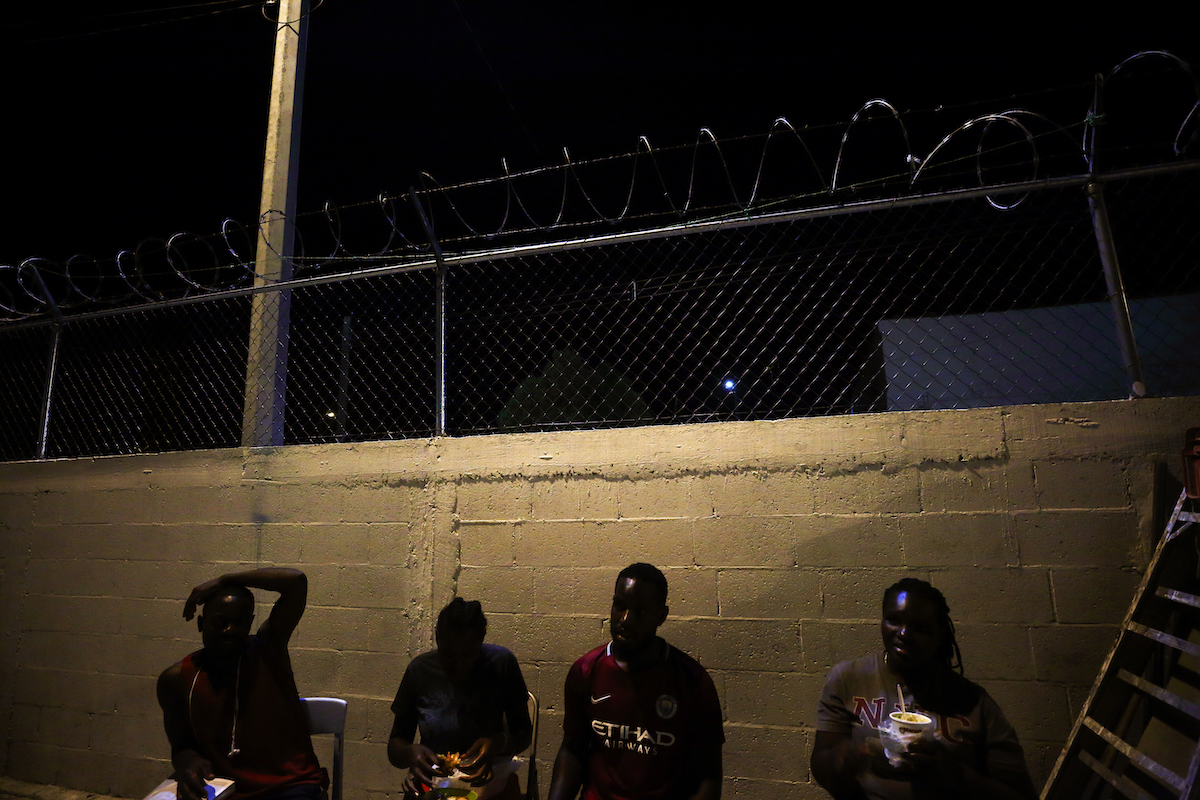

In this July 24, 2019, image, Africans sit in folding chairs at Buen Pastor migrant shelter in Ciudad Ju®arez, Mexico. (AP Photo/Gregory Bull)
Some word choices feel steeped in symbolism: War. Sieges. Quit.
Samrah can still tell you about her best word: Squeeze. She got 50 points for it. The spiral notebook where she keeps score in blue ballpoint pen is filling quickly, interspersed with notes. “LEGAL STANDARD FOR ASYLUM,” one shouts in capital letters.
***
An 8-year-old Congolese girl is playing in the courtyard when she suddenly asks for her mother. A Cuban walking back from the shower area overhears her.
“Your mother is far from here,” he tells her. They’re speaking Portuguese, a language they share because he once lived in Portuguese-speaking Brazil and she was born in a village in Congo near the border with Portuguese-speaking Angola.
“Where?” the girl asks.
The girl’s mother is dead, killed in political violence in 2016. The woman she calls her mother is the aunt who helped raise her, and who stayed behind when the girl’s family left, hoping to reach America.
“Far,” the Cuban tells her. “In Africa.”
Long after sunset the Congolese girls’ father sits silently on a bench near a row of power outlets, charging his phone as he scrolls through the news, messages friends and watches videos to work on his English skills.
He’s a distinguished-looking man with close-cropped hair and a beard going gray. He speaks three languages fluently and a smattering of others. He studied to work on large-scale electrical projects, but in the chaos of Congo, where the economy barely functions in many regions, he survived as an electrician.
Shelter life weighs heavily on him. He worries what it’s doing to his children. He’s known among the migrants for agonizing about what he should do.
In the spring, he and his three children flew from Angola to Colombia, where they met up with a couple hundred other Congolese migrants. The caravan spent 70 days in the jungles of Panama before making their way to Mexico. Then they separated, each rolling the dice on the limited information they had. He went to Juarez; his friends went elsewhere. At least a handful got through U.S. immigration. Some are now living in Maine.
“I could make a life there. This is not a life,” he says, the words spilling out rapidly and bitterly. “My head isn’t in a good place here. The stress is not bearable.”
He spends his days sifting among the rumors that filter through migrant discussions on Facebook and WhatsApp: Try a border crossing into New Mexico, someone says. Try near San Antonio says another. Just go illegally, some say, arguing there are plenty of places to cross.
One days, he takes his children to a Juarez park that runs along the border. El Paso is right in front of them, just a few steps away. Migrants sometimes slip through the park and cross the border in broad daylight, though most are grabbed as soon as they reach U.S. soil.
He insists he wasn’t thinking of crossing illegally.
“I was just going into town,” he grumbled. “I like to get my kids out of here.”
“I can’t stay here all the time.”
***
A few weeks later, he is gone.
Just before he disappeared with his family, the Congolese man told Fierro they had to leave. They’d cross illegally.
“Pastor, I’m out of hope,” he told the pastor. “I can’t wait anymore.”
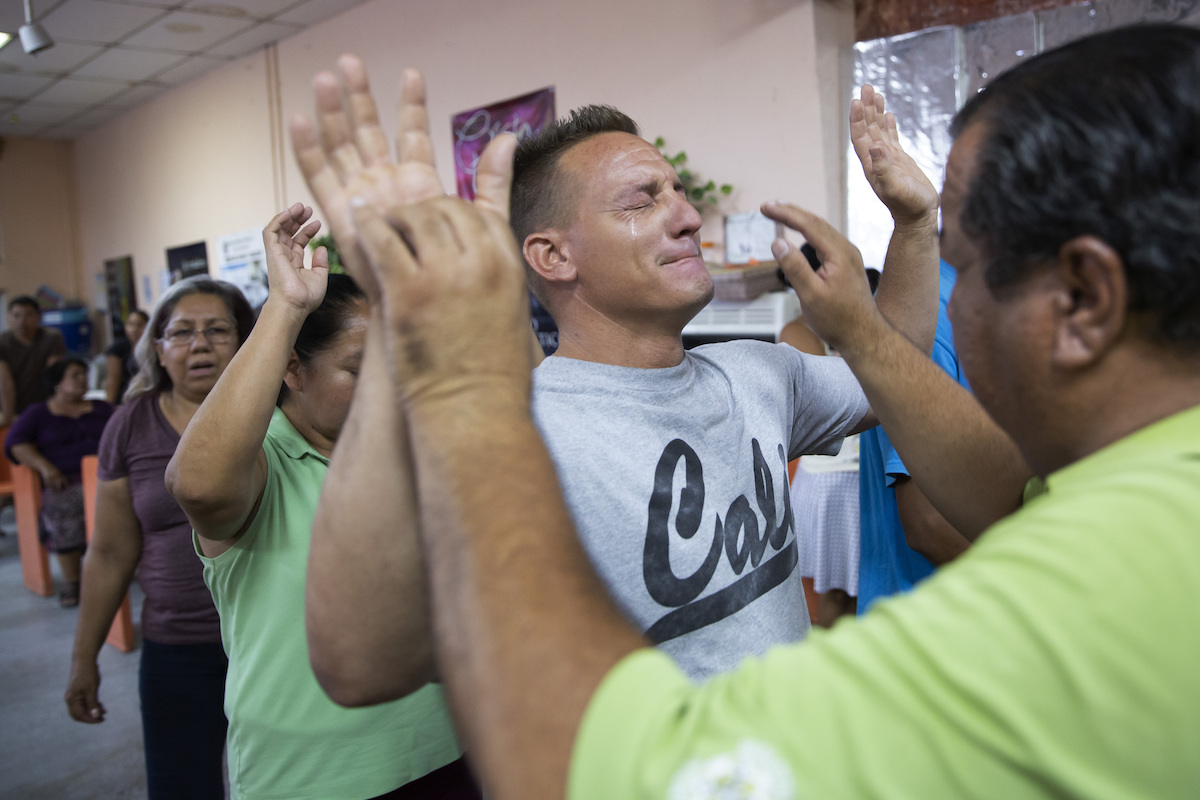

In this July 25, 2019, photo, pastor Juan Fierro, right, touches Miguel, of Cuba, during services at El Buen Pastor shelter for migrants in Ciudad Juárez, Mexico. (AP Photo/Gregory Bull)
Fierro doesn’t know what happened to them. It’s unclear if they turned themselves in to Border Patrol agents, or if they made it to Maine.
Some other changes have come to El Buen Pastor.
Alphat made it to the United States. He slipped through a narrow loophole in the ever-tightening U.S. immigration policies. Although he didn’t request asylum until after the July 16 ruling requiring migrants to first ask for asylum in another country, his claims of torture meant the U.S. had to admit him under international treaty obligations. He is currently being held in detention while his asylum case is reviewed, according to lawyers who have been in touch with him.
The Nicaraguan teenager and the Ugandan man broke up. The teenager’s family, still waiting for their number to be called to legally ask for asylum in the U.S., will likely be deported back home or to another country they passed through—regardless of the merits of their claims.
For those who remain at El Buen Pastor, each day is just another in limbo.
By 11 p.m. the courtyard is crowded with mattresses. Nearly everyone is asleep. It’s quiet, except for the gentle rumble of snoring and the occasional dog barking in the neighborhood.
A half-hour or so later, a little girl emerges from the chapel where the families sleep, and where the clock on the wall has stopped at 10:14. She begins dancing in the courtyard under a streetlight, swinging a thin blanket around her like a dancer twirling her skirt. Her face is filled with joy.
Her mother is one of the few people still awake, sitting on a wooden bench staring absently at her phone.
Five minutes later the girl is lying across her mother’s lap, sound asleep. Her mother, face bathed the phone’s electric glow, barely notices.


